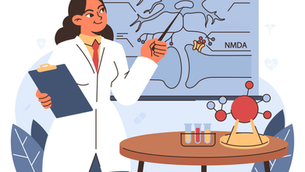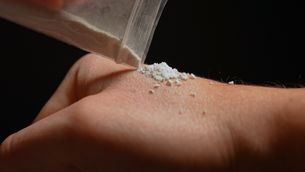
Ketamine

Ketamine (ketamine hydrochloride) is a dissociative anaesthetic and analgesic (pain killer). Ketamine was developed in the 1960s and FDA approved in the 1970s for medical use and is now used widely throughout the world in both humans and animals. In the 1980’s not long after its approval it began to be used as a recreational drug due to its dissociative and psychedelic properties.
Other names for ketamine are known as ‘Ket’, ‘Special K’, or simply know as ‘K’.
Ketamine is white/transparent when pure, and often sold in its crystal form. It is crushed into a fine powder so it can be snorted up the nose and absorbed more effectively. Occasionally the powder can be other colours, such as off-white or brown.
Ketamine also sometimes comes in capsules or pills. These could contain other drugs, which increases the risk of a bad reaction. It has even been sold as or confused with ecstasy pills and is sometimes lased with methoxetamine.
Some people get ketamine in liquid form (or dissolve it) and inject it for a faster, stronger effect. Injecting drugs is more dangerous for many reasons. For example, it is easier to take too much and can cause injuries and infections such as HIV (sharing needles).
Ketamine is a dissociative anaesthetic. When used medically, at high doses to block pain signals it produces a state of unconsciousness. The lower doses used recreationally produce very different effects, sometimes including hallucinations, which are not well understood. There are similarities between the strange states of mind caused temporarily by ketamine and the experiences of people suffering from schizophrenia. It is hypothesised that ketamine works via a disinhibition mechanism on the main excitatory neurones within the central nervous system.
The effects of ketamine can feel very dream-like and detached as well as feeling, relaxed, happy, and confused. When snorted the effects of ketamine are felt relatively fast 10-15 minutes, a pill form can take around 20 minutes whereas, injections are almost immediate. These psychoactive effects can last for between 30 minutes to an hour depending on how much has been taken. It is however thought that ketamine can stay in the blood stream for around 24 hours.
Ketamine is an essential medical and veterinary drug used for anaesthesia and pain relief under a wide range of circumstances. Ketamine is much less likely than other anaesthetics to depress the heart and respiration, so it is the anaesthetic agent of choice in low-income countries and in environmental/conflict disasters where there are few trained medical personnel, anaesthetic machines, or consistent sources of electricity. In the western world ketamine is commonly used as veterinary anaesthetic, particularly in horses. In western countries ketamine is less commonly used for routine anaesthesia in people as it may cause hallucinations during recovery; more conventional anaesthetics are preferred where trained anaesthetists and appropriate equipment are readily available to monitor the patient and support respiration.
Ketamine is a potent pain killer and is particularly useful for children undergoing agonizing procedures such as treatment of burns. It is now also an important treatment for chronic pain.
New therapeutic uses for ketamine have more recently been identified, including treatment of depression, refractory status epilepticus, alcohol use disorder, and PTSD. A single low dose of ketamine can rapidly lift depression, although the effect does not last long-term. It is thought to work by causing new connections (synaptic plasticity) to be made in the brain through its disinhibition mechanisms. This is a promising lead for the development of new treatments as conventional antidepressants take some time to work. Self-treating using ketamine puts the user at risk of the harmful effects of ketamine, and it has not yet been established through large-scale trials that the benefits outweigh the risks.
Ketamine produces very different effects depending on the dose taken. It is a potent drug, and it is easy to take more than intended. It is therefore better for inexperienced users to start with a small dose first before considering a larger dose.
Low to moderate doses
Ketamine can give sensations of lightness (like walking on the moon), dizziness, and euphoria. It makes people’s thoughts flow randomly; ideas can seem special and important, or pleasantly or unpleasantly muddled. Things may begin to look and sound different or somehow unreal. There is always a higher risk of accidents whilst using ketamine. Taking any depressant drug, such as alcohol, can very easily and quickly make the effects much stronger and riskier.
Higher doses
The more ketamine that is taken, the harder it is to stand up and move about. Quite large quantities lead to exceptionally odd feelings such as separation between the mind and the physical body, which some find pleasurable, and others find distressing. Unpleasant side-effects like nausea and vomiting can occur. Ketamine can produce delusional thoughts much like those associated with schizophrenia. Very large quantities lead to users losing touch with their identity and surroundings altogether, which is called k-holing. People k-holing may be unresponsive, although inside their mind they may be experiencing vivid hallucinations. Users can have notions and hallucinations which can feel very real, and can be anything from wonderful conversations with angels, to being convinced they are dying. The risks of accidents, overdoses and anxiety described below are increasingly significant at higher doses especially when taken with alcohol.
People who die or end up in hospital almost always have combined ketamine with other drugs, particularly alcohol. Taking ketamine with stimulants (such as cocaine and ecstasy) may overload your heart. Taking it with depressants (such as alcohol, GBL or heroin) may make you become unexpectedly unconscious and can stop your breathing or allow you to suffocate on your own vomit.
Ketamine works in several ways to make you particularly vulnerable to accidental injury and death; even smaller amounts will decrease your ability to make sensible decisions or recognize dangers (like roads). Larger amounts have anaesthetic effects; people have died by lying outside on a cold night without awareness of the cold, and by falling unconscious in the bath and drowning.
Tripping on ketamine can be an utterly overwhelming experience, especially if the user does not expect its powerful effects. Users can freak out whilst taking it and sometimes end up being rushed to hospital. Such anxiety attacks produce a dangerously racing heart and palpitations as well as extreme agitation. This can be a seriously traumatic experience, even if it doesn’t cause physical harm.
People with schizophrenia, or who have ever suffered a psychotic episode, should avoid ketamine. The drug has been demonstrated to bring back symptoms of psychosis, and these could persist beyond the period when the drug is in the body.
Drugs which radically affect consciousness are more likely to cause panic and fear in people who suffer anxiety, whether this has been diagnosed as a disorder or not.
Ketamine increases heart rate and blood pressure. These effects are usually quite minor but could be dangerous for people with related health problems or who combine it with other drugs.
Using Ketamine on a regular basis over a long period of time has been shown to result in altered bladder functions; commonly known as ketamine-induced cystitis. This damage is thought to be irreversible.
When people die after taking ketamine, they usually combine it with another substance.
Taking with depressants (such as alcohol, GBL, benzodiazepines such as Valium, or opiates such as heroin) may make you become unconscious unexpectedly and can stop your breathing or enable you to suffocate on your own vomit.
Taking ketamine with stimulants (such as cocaine and ecstasy) may overload your heart. The chance of agitation and anxiety is also increased. Stimulants may keep you moving when the effects of ketamine would otherwise have immobilised you, increasing the chance of accidental injury.
Whilst many people use ketamine on occasion without feeling cravings, some people get addicted to ketamine use and may use it daily. People can struggle and fail to be able to stop using ketamine. Tolerance builds up, so users need much more ketamine to get the effects they like. Signs of tolerance should be considered an early warning sign of addiction and harmful use.
Psychological addiction is also an occurrence that some users can experience. This means they can form an emotional as well as physical dependence due to the relief ketamine can provide from mental strain.
People addicted to ketamine can suffer strong cravings, anxiety, and misery, and even shaking and sweating when they try to go without. Such withdrawal symptoms are not dangerous and eventually pass.
Addictive regular use of ketamine can cause serious mental and physical harm.
Mental impairment
Taking ketamine regularly seems to affect the mind, particularly memory. The effects are not serious enough to count as a mental disorder, but regular users may feel that they’re not nearly as sharp as they should be. This can be due to ketamine’s dissociative effects. Feeling generally dissociated could be very bad for work, education, and relationships. These harmful effects seem to fade when people give up the drug.
Urinary system damage
People who use ketamine multiple times a week are at high risk of damaging their kidneys and especially their bladder. Once the damage is done, the organs do not always recover. The bladder condition, called ketamine-induced ulcerative cystitis, starts with the need to urinate very often, and leads to painful urination. Sufferers may be prone to wetting themselves and can have blood in their urine due to crystal formation. A few young people have had to have their damaged bladder removed, which leaves men unable to get a natural erection and both genders unable to urinate naturally for life. This disease can even encourage more ketamine use, or prevent users quitting, as ketamine temporarily eases the pain.
Ketamine cramps
Regular users get severe abdominal pain often called k-cramps. Their cause is unknown, but they seem distinct from the bladder damage.
There are always risks to using ketamine. However, if you do take drugs, you can make simple choices to improve the chances of a good experience, rather than a regretted, harmful, or even fatal one. Here are some things to consider.
How much are you taking and how often?
Taking bigger amounts, and taking it frequently, means higher risks. The most severe harms, including permanent bladder damage, affect people who take ketamine regularly.
First time users should be especially cautious with dose. Some users plan and measure out how much they intend to take, and only have that amount accessible. Otherwise, it can be tempting to keep taking more whilst you are less capable of making sensible decisions. It’s important to keep track of whether you or your friends are taking increasingly large amounts, or using ketamine increasingly often, as this can be a sign of an addiction developing.
Are you taking anything else? Mixing drugs is much riskier.
Drug effects are unpredictable, but mixing drugs makes the effects on your body and mind even harder to control. Deaths after ketamine use usually involve mixing it with other drugs. Ketamine plus another sedating drug like alcohol can stop you breathing.
How appropriate is your setting and state of mind?
If you are anxious, or feeling down, the drug may exaggerate these feelings and give you an unwanted experience. Additionally, if you are in a stressful, unfamiliar environment with strangers, the risk of having a bad time, or experiencing physical harm, is increased.
Related Content
Support our work and help ensure that evidence-based research can influence policy and public opinion, not political or commercial agenda.
Drug Science is an independent, science-led drugs charity. We rely on donations to continue to promote evidence-based information about drugs without political or commercial interference.
We are grateful … But we need more. We can’t do it alone. Becoming a donor will help ensure we can continue our work. Join our Community and access opportunities to become more deeply engaged in our work.








